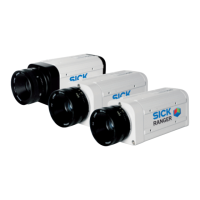Chapter 5 Reference Manual
Ranger E/D
46 ©SICK AG • Advanced Industrial Sensors • www.sick.com • All rights reserved
Configuring Ranger E and D
The Position, Direction and Movement modes require that both encoder phases are con-
nected to the Ranger. The pulse triggered mode can be used if only 1 of the 2 encoder
phases is connected.
Figure 5.6 – An encoder will keep object proportions when conveyor speed changes
The internal pulse counter will also be reset every time a measurement is started by the
Enable signal, and when a parameter is changed while measuring (using the setParam-
eterValue() method).
5.5.2 Embedding Mark Data
When an encoder is connected to the Ranger, it is possible to make the Ranger send
encoder data – or mark data – with the profiles delivered to the PC.
This can be useful for example when measuring in free-running mode to find the actual
distance between two scans if the speed of the object varies, for placing the measurement
data in a timeline, or when registering color images.
The Ranger can embed two types of mark data in the profiles:
Normal mark data Either encoder value (number of encoder pulses) or se-
quence number for the scan.
Status information such as status of Enable and Encoder
inputs when the scan was made, and number of overtrigs
that may have occurred.
Extended mark data Both encoder value and sequence number for the scan.
Status information such as status of Enable and Encoder
inputs when the scan was made, and number of overtrigs
that may have occurred.
Time stamps for when the scan was made and for the most
recent encoder tick.
Extended mark data should be used when capturing color images, in order to get the most
accurate and robust color registration.
The encoder value in the extended mark data can be set to represent different things:
Position Value reflects the position of the encoder. It is increased when the en-
coder moves forwards and decreases when it moves backwards. This al-
low for accurately tracking the position of an object moving both forwards
and backwards.
Motion Value reflects the motion of the encoder. It increases regardless of the
encoder direction. This allows for accurately tracking the distance an ob-
ject has traveled.
The time base for the clock used for the time stamps is 33 MHz. It is stored as a 32-bits
integer, which gives approximately 2 minutes of counting before it wraps around.
The structure of the information in the mark data is described in section 8.2.5 “Mark
Data”. The parameters used for configuring the camera to send mark data is described in
section 6.4 “Measurement Configuration” for Ranger D, and 7.4 “Measurement Configu-
ration” for Ranger E respectively.
No encoder Object propor-
tions are incorrect
Encoder Object propor-
tions are correct
☺

